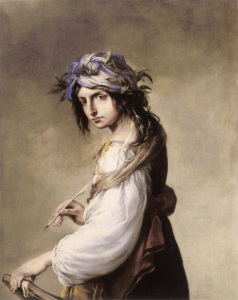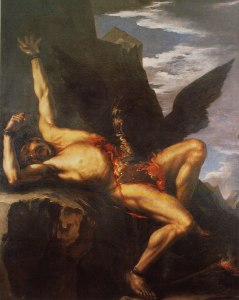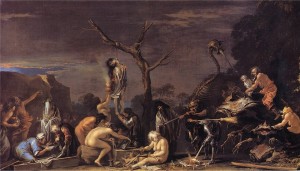CLASS: BONE DEEP GOTHIC
Curious what this is all about? Find out here!
Although Rosa was not quite obscure when he arrived in Florence, he was hardly famous either. He settled there at the invitation of Carlo de’Medici. In the mid-17th century, the Medici Court was still a formidable political dynasty. In the spirit of the Italian Renaissance, they were not only part of a ruling aristocracy, but were also generous and enthusiastic patrons of the arts and sciences, and movers-and-shakers within the Church hierarchy as well. In one ambitious and boastful fresco, populated with both contemporary Medici and renowned figures of antiquity, visitors are admonished to “talk little, and be brief and witty.” (Langdon 19).
Within this environment that valued talent, erudition, and a clever tongue, Rosa quickly became a star. He painted ambitious celebratory landscapes for the likes of Ferdinand II and Giovan Carlo and appalled and delighted the Florentines with his distinctly Neopolitan style, which manifested in a gritty and even grisly attention to grotesque detail, as in his “Prometheus.”
However, this amicable relationship with the Medici court was not to last. Already sensitive of his humble beginnings, and proudly conscious of his talent, Rosa felt slighted by inconsistent recognition and repelled by the dissimulation and excess of court life. Gradually, he became drawn into the thriving Florentine artistic and intellectual scene. As a painter who had also participated quite successfully in the theater of the day and who had dabbled in literature, Rosa was immediately received into this community and quickly became one of its most compelling and provocative figures.
Rosa’s inner circle comprised the intellectuals Giovannie Battista Ricciardi and Ugo Maffei. This as also when he met his lifelong companion and deathbed wife, Lucrezia Paolini. With these and other artist-intellectuals, Rosa formed the Accademia dei Percossi, one of a number of Florentine salons that combined painting, philosophical rumination, biting satire, and theatrical performance. Through the Percossi, Rosa would write bitterly caustic satires in the spirit of the Juvenal, always attacking the degeneracy and injustice of the influential courts, at the expense of the pure, the artists, and the downtrodden. As Rosa absorbed himself ever more into the artistic scene of Florence, he also became estranged from the Medici. By the end of his time in the city, Rosa was financially supported more by artists and lone connoisseurs than by patronage from the court. Additionally, the subjects of his paintings became more abstruse and eccentric. Rosa would later reflect that this was the happiest time of his life.
Despite this rare contentment in an otherwise stormy and unpredictable life, Rosa’s work would seldom be more gloomier than it was in Florence. His satires and performances were almost universally pessimistic. He also embarked on a series of weird paintings that would be particularly resonant to the English gothicists who would look to Rosa as a genius and kindred spirit: his witchcraft paintings. These works showed groups of witches conducting unholy sabbaths, often featuring such elements as demonic steeds, profane magic, and human sacrifice, drawn from a Northern European milieu popular in Italy at the time. Rosa’s tour de force in this category was his “Scene of Witchcraft,” (pictured below) a massive painting that would be used as a show-stopper by both Italian and later English collectors.
But familiar as the imagery is to us today — it could be a crowded baroque inventory of gothic tropes — it would be a mistake to think of these works as “gothic.” One of the most important things to remember when looking at the relationship of Salvator Rosa to the later gothicists is that the gothic aesthetic did not exist in Rosa’s time, nor did the word “gothic” have any particular significance to Rosa. He was not painting to evoke feelings of dread or sublimity among viewers enjoying a safe “distance” from the subject; these concepts had not yet been articulated in their current form. Rosa was painting for the intellectual class of the time, for the politically connected elite, and for wealthy patrons; his work is alternately tinged with reverie, satire, playfulness, and study. Paintings like “Scene of Witchcraft” were not meant to invoke a straightforward horror in their viewers, so much as to prompt fascination, contemplation, and even amusement.
Now this is not to say that these qualities are absent from later Gothic art; indeed, the best gothic art makes great use of layered dichotomies even while inspiring legitimate dread and horror in its audience. It is to say, however, that an accurate appreciation for Rosa’s work during his own lifetime and as he conceived it requires separation from later definitions of the gothic. “Scene of Witchcraft” would be just as meaningful in the 18th century as it was in the 17th, but the meaning of the painting had been thoroughly transformed over the years and as received by a very different culture.
Sources:
Helen Langdon, Salvator Rosa



